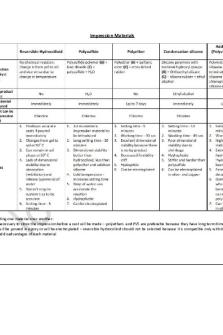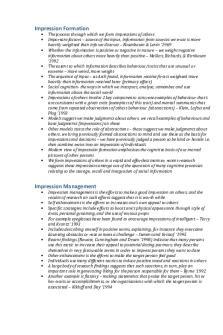Impression Formation and Impression Management PDF

| Title | Impression Formation and Impression Management |
|---|---|
| Course | Social Psychology |
| Institution | Bournemouth University |
| Pages | 2 |
| File Size | 46.4 KB |
| File Type | |
| Total Downloads | 113 |
| Total Views | 143 |
Summary
Download Impression Formation and Impression Management PDF
Description
Impression Formation
The process through which we form impressions of others Important factors – source of the input, information from sources we trust is more heavily weighted than info we distrust – Rosenbaum & Levin ‘1969 Whether the information is positive or negative in nature – we weight negative information about others more heavily than positive – Mellers, Richards, & Birnbaum ‘1992 The extent to which information describes behaviour/traits that are unusual or extreme – more weird, more weight The sequence of input – as Asch found, information receive first is weighted more heavily than information received later (primacy effect) Social cognition- the ways in which we interpret, analyse, remember and use information about the social world Impressions of others involve 2 key components: concrete examples of behaviour that’s are consistent with a given trait (exemplars of this trait) and mental summaries that come from repeated observations of others behaviour (abstractions) – Klein, Loftus and Plog ‘1993 Models suggest we make judgments about others, we recall examples of behaviours and base judgments (impressions) on these Other models stress the role of abstractions – these suggest we make judgments about others, we bring previously formed abstractions to mind and use these as the basis for impressions and decisions – we have previously judged a person to be kind or hostile i.e. then combine traits into an impression of individuals Modern view of impression formation emphasises the cognitive basis of our mental pictures of other persons We form impressions of others in a rapid and effortless manner, recent research suggests these impressions emerge out of the operation of many cognitive processes relating to the storage, recall and integration of social information
Impression Management
Impression management is the efforts to make a good impression on others, and the results of research on such efforts suggest that it is worth while Self enhancement is the efforts to increases one’s own appeal to others Specific strategies include efforts to boost one’s physical appearance through style of dress, personal grooming, and the use of various props For example eyeglasses have been found to encourage impressions of intelligent – Terry and Krantz ‘1993 Includes describing oneself in positive terms, explaining, for instance they overcame daunting obstacles or rose to meet a challenge – Stevens and Kristof ‘1995 Recent findings (Rowatt, Cunningham and Druen ‘1998) indicate that many persons use this tactic to increase their appeal to potential dating partners; they describe themselves in very favourable terms in order to impress persons they want to date Other enhancement is the efforts to make the target person feel good Individuals use many different tactics to induce positive mood and reactions in others A large body of research findings suggests that such reactions, in turn, play an important role in generating liking for the person responsible for them – Byrne ‘1992 Another example is flattery – making statements that praise the target person, his or her traits or accomplishments, or the organisations with which the target person is associated – Kilduff and Day ‘1994
Paulhus, Bruce and Trapnell ‘1995; Wayne and Kacmar ‘1991 – indicate that impression management tactics often do succeed in enhancing the appeal of persons who use them effectively Vonk ‘1998 – strong evidence for what he terms the ‘slime effect’ – a tendency to form very negative impressions of people who in a work setting play up to their superiors but treat subordinates with disdain and contempt Many of the factors that influence our impressions of others are not easily “managed” or controlled – we form impressions of others independent of their efforts to look good – Berry ‘1991 and DePaulo ‘1992 Such characteristics strongly influence our impressions of others, but can’t readily be altered by them Berry ‘1997 found that impressions individuals make on others are often strongly affected by such factors as facial appearance (baby faced or mature faced) and subtle aspects of their speech (present or past verbs)...
Similar Free PDFs

Impression Management Notes
- 3 Pages

Impression Materials
- 2 Pages

First impression
- 9 Pages

Memoire bon impression
- 47 Pages

FIS 205 Impression Evidence
- 9 Pages

Chapter 22 Impression Evidence
- 4 Pages

Partnership Formation and Operation
- 36 Pages
Popular Institutions
- Tinajero National High School - Annex
- Politeknik Caltex Riau
- Yokohama City University
- SGT University
- University of Al-Qadisiyah
- Divine Word College of Vigan
- Techniek College Rotterdam
- Universidade de Santiago
- Universiti Teknologi MARA Cawangan Johor Kampus Pasir Gudang
- Poltekkes Kemenkes Yogyakarta
- Baguio City National High School
- Colegio san marcos
- preparatoria uno
- Centro de Bachillerato Tecnológico Industrial y de Servicios No. 107
- Dalian Maritime University
- Quang Trung Secondary School
- Colegio Tecnológico en Informática
- Corporación Regional de Educación Superior
- Grupo CEDVA
- Dar Al Uloom University
- Centro de Estudios Preuniversitarios de la Universidad Nacional de Ingeniería
- 上智大学
- Aakash International School, Nuna Majara
- San Felipe Neri Catholic School
- Kang Chiao International School - New Taipei City
- Misamis Occidental National High School
- Institución Educativa Escuela Normal Juan Ladrilleros
- Kolehiyo ng Pantukan
- Batanes State College
- Instituto Continental
- Sekolah Menengah Kejuruan Kesehatan Kaltara (Tarakan)
- Colegio de La Inmaculada Concepcion - Cebu








